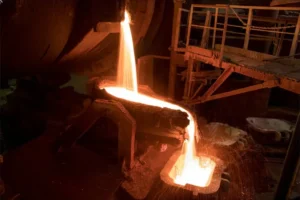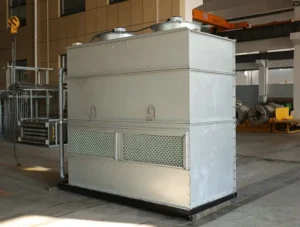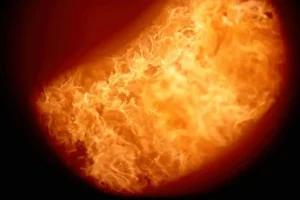During the induction furnace melting process, inclusions are a critical factor affecting the final quality of castings. They disrupt the continuity of the metal matrix, serving as stress concentration points and crack initiation sites, which significantly reduces the material’s mechanical properties, such as strength, ductility, and fatigue life. Accurately distinguishing the source of these inclusions—whether they are “endogenous” products of the melting process or “exogenous” contaminants introduced from external sources—is the fundamental prerequisite for implementing effective control measures and resolving quality issues.
This guide will focus on two core micro-analytical techniques: Metallographic Analysis and Scanning Electron Microscope/Energy-Dispersive Spectroscopy (SEM/EDS) Analysis.
Part 1: Classification and Basic Characteristics of Inclusions
Endogenous Inclusions
- Definition: Products formed from chemical reactions that occur within the molten steel or iron during melting, refining, and solidification.
- Formation Mechanisms:
- Deoxidation Products: Oxides formed after deoxidizers (e.g., Si, Mn, Al) are added to remove oxygen from the liquid metal, such as SiO2, MnO, and Al2O3.
- Precipitates: Certain elements (e.g., S, N) whose solubility in liquid or solid metal decreases with temperature will precipitate out and combine with other elements to form sulfides and nitrides, such as MnS and TiN.
- General Characteristics:
- Size: Usually small, often in the micron range.
- Distribution: Relatively dispersed and uniform.
- Shape: Exhibit a certain regularity, often spherical, punctiform, spindle-shaped, or chain-like.
Exogenous Inclusions
- Definition: Non-metallic substances mechanically introduced into the molten metal from external sources.
- Sources:
- Refractory Materials: Spalling, erosion, or corrosion of refractory linings from the furnace, ladle, or tundish, such as Al2O3−SiO2, magnesia, or spinel particles.
- Slag/Covering Flux: Slag that is not properly skimmed or is entrained during tapping.
- Charge Materials: Uncleaned rust, sand (SiO2), or dirt on the surface of scrap steel or pig iron.
- Molding Materials: Sand grains entrained from the mold cavity during sand casting.
- General Characteristics:
- Size: Usually large, sometimes even visible to the naked eye.
- Distribution: Uneven, often appearing as large, blocky, and randomly located clusters.
- Shape: Extremely irregular, with sharp angles.
Part 2: Identification and Analysis Methods
Step 1: Metallographic Analysis (Preliminary Qualitative and Morphological Observation)
A metallographic microscope is the primary and fastest screening tool. By observing the metallographic image of a polished (un-etched) sample, a preliminary judgment can be made based on the inclusion’s morphology, size, color, distribution, and hardness (polishing marks).
Metallographic Features of Endogenous Inclusions:
Sulfide (MnS): Appears gray and is ductile. It deforms during hot working and elongates into stringers or spindle shapes in the rolling direction. In the as-cast condition, it often appears as dots or a network at grain boundaries.
Oxide (Al2O3): Hard and brittle with no ductility. It exists in steel as small, high-melting-point particles that appear black or dark gray. In killed steel, they tend to cluster, forming chains or groups at grain boundaries. Due to their high hardness, they easily pull out during polishing, leaving behind “comet tails” or pits around the inclusion.
Silicate (SiO2−MnO): Has a plasticity between that of sulfides and alumina. It is typically spherical or ellipsoidal and will be elongated during hot working, but to a lesser extent than MnS. It appears black or dark gray, often resembling a glassy phase.
Metallographic Features of Exogenous Inclusions:
Refractory Spalling: Enormous in size, with an extremely irregular shape and distinct angular features. It is usually a multi-phase structure, with visible grains of different mineral phases. It appears randomly and is typically a large, isolated block.
Entrained Slag: Also typically large in size and irregular in shape, but with more rounded edges compared to refractory materials. Colors are diverse, possibly appearing as a transparent or translucent glassy phase.
Summary: In a metallographic image, “large size, irregular and angular shape, random and isolated distribution” are the typical signs of an exogenous inclusion. In contrast, “small size, regular shape (spherical/stringer), and dispersed distribution” are more indicative of an endogenous inclusion.
Step 2: SEM/EDS Analysis (Precise Composition Confirmation and Tracing)
When metallographic analysis provides a preliminary judgment, SEM/EDS is the “gold standard” for final confirmation and tracing.
- SEM (Scanning Electron Microscope): Provides higher magnification and a greater depth of field than a metallographic microscope, allowing for a clearer view of the inclusion’s micro-morphology and multi-phase structure.
- EDS (Energy-Dispersive Spectroscopy): Performs qualitative and semi-quantitative elemental analysis on a selected micro-area, which is the key to tracing the inclusion’s source.
Differences in EDS Spectra of Endogenous vs. Exogenous Inclusions
| Inclusion Type | Typical EDS Element Spectrum | Source Determination |
| Endogenous Inclusions | ||
| Alumina (Al2O3) | Strong Al,O peaks | Aluminum deoxidation product |
| Manganese Sulfide (MnS) | Strong Mn,S peaks | Mn and S precipitation in steel |
| Silicate | Si,Mn,O peaks, sometimes with small amount of Al | Silicon-manganese deoxidation product |
| Titanium Nitride (TiN) | Strong Ti,N peaks | Precipitation of trace Ti and N in steel |
| Exogenous Inclusions | ||
| Alumino-silicate Refractory | Strong Al,Si,O peaks, with proportions close to refractory brick composition | Clay bricks or high-alumina bricks from furnace lining, ladle, etc. |
| Magnesia Refractory | Strong Mg,O peaks, often with Ca,Si,Al | Basic refractory materials like magnesia or magnesia-lime bricks |
| Spinel | Strong Mg,Al,O peaks | Magnesia-alumina spinel refractory materials |
| Entrained Slag | Complex elemental combination, like Ca,Si,Al,Mg,O, with proportions similar to refining slag | Improper slag skimming or slag entrainment |
| Sand Grains | Almost pure Si,O peaks | Sand or dirt carried in by charge materials |
Example of Targeted Tracing:
- EDS result for inclusion is Mg,Al,O → Target: Check if the magnesia-alumina spinel ladle or furnace lining is spalling or severely corroded.
- EDS result for inclusion is Ca,Si,Al,O → Target: Review the slag skimming process, optimize the slag dam or tapping procedure to prevent slag entrainment.
- Excessive Al2O3 inclusions are found in clusters → Target: This is not an external issue. The aluminum deoxidation process should be optimized, for example, by adjusting the timing or amount of aluminum addition, or by considering wire feeding or calcium treatment to modify the inclusions and improve their floatability.
Part 3: Summary and Action Guide
| Characteristic | Endogenous Inclusions | Exogenous Inclusions |
| Formation Mechanism | Chemical reaction within molten metal | Mechanical mixing of external substances |
| Metallographic Shape | Regular: spherical, punctiform, spindle-shaped, stringer | Irregular: large, blocky, angular |
| Size | Small, usually <50µm | Large, usually >100µm, even mm scale |
| Distribution | Relatively dispersed, uniform, or at grain boundaries | Random, isolated, non-uniform |
| EDS Elements | Simple, e.g., Al−O, Mn−S, Si−Mn−O | Complex combinations, e.g., Al−Si−Ca−Mg−O |
| Problem Source | Melting process: deoxidation, alloying, temperature control | External contamination: refractories, slag, charge materials |
| Solution Target | Optimize deoxidizers, refining process, pouring temperature | Improve refractory quality, clean charge materials, enhance slag skimming and blocking procedures |
Conclusion: By using the combined approach of “metallography for morphology, SEM/EDS for composition,” you can very precisely identify inclusions in induction furnace melting.
- Preliminary Screening: Use a metallographic microscope to quickly scan samples and perform a preliminary classification for over 90% of the inclusions based on their size and morphology.
- Precise Diagnosis: Conduct SEM/EDS analysis on typical, suspicious, or large inclusions found in the metallography to obtain their exact chemical composition.
- Accurate Tracing: Compare the EDS composition with the materials used in the melting process—such as refractories, slag, and charge materials—to pinpoint the source.
This method transforms the vague problem of “there are inclusions in the casting” into a precise diagnosis like “the casting contains magnesia-alumina spinel particles originating from the XX furnace lining.” This provides a clear and accurate target for process improvement, avoiding the time and cost wasted on blind adjustments.







